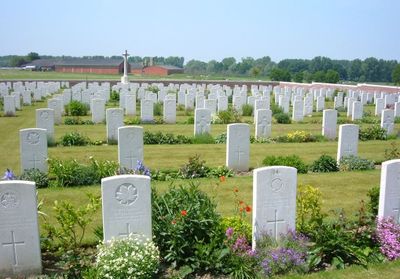Frederick William Scott
From Our Contribution
 | |
| Personal Information | |
|---|---|
| Date of Birth | 19 Aug 1893 |
| Place of Birth | Jarrahdale, Western Australia |
| Death | 15 Oct 1916 |
| Place of Death | Wytschaete, Belgium |
| Age at Enlistment | 21 years old |
| Description |
5'6¾" (1.m) tall ; 128 lbs 58.06 kg ; fair complexion ; blue eyes ; light brown hair |
| Occupation | Labourer |
| Religion | Church of England |
| Address | NOK Whittaker's Mill, North Dandalup |
| Next of Kin | Mother , Mrs Annie Scott |
| Military Information | |
| Reg Number | 121 |
| Date of Enlistment | 9 Sep 1914 |
| Rank | Lance Corporal |
| Unit/Formation | 16th Battalion, B Company, transferred to 45th Battalion |
| Date of Embarkation | 22 Dec 1914 ‒ 1 Feb 1915 |
| Ship Embarked On | HMAT A40 Ceramic |
| Date of Return |
Port Melbourne to Alexandria "Port Melbourne to Alexandria" contains an extrinsic dash or other characters that are invalid for a date interpretation. |
| Fate | Killed in Action 15 Oct 1916 |
| Monument |
Jarrahdale Honour Roll Australian War Memorial |
| Medals |
1914-15 Star British War Medal Victory Medal |
War Service
Frederick enlisted at the Perth Drill Hall on 9 Sep 1914. Soon after entering Blackboy Hill camp, Fred was allocated to 'B' Company of the 16th Battalion. With the battalion, he was sent to Melbourne to undertake Brigade level training at Broadmeadows camp. The ships used between Fremantle and Melbourne were the SS Dimboola; SS Indarra; SS Ophir; and SS Katoomba, with B Company embarking on SS Indarra on 21 November and arriving in Adelaide on 25 November and Melbourne on 28th Nov 1914 at 7:30am. It was from Port Melbourne that they sailed to be part of the first convoy to the Middle East. On 22 Dec 1914 the battalion began boarding HMAT A40 Ceramic at Port Melbourne, with the ship casting off at 2:30pm and sailing for Albany where it arrived on 27 Dec 1914. After arriving at Alexandria in Egypt on 1 Feb 1915, they disembarked and travelled by train to their new base at Heliopolis near Cairo, arriving early on 4 Feb 1915.
Fred's records do not contain information to confirm that he was with the battalion when it landed at Gallipoli, but subsequent entries imply that he was. On 1 May 1915 he was admitted to the 17th General Hospital in Alexandria for treatment for a severely injured bladder. His records show him as being released to duty on 13 May 1915 at Mustapha Convalescent Camp in Alexandria. Two weeks later on 26 May 1915 he was admitted to the 2nd Australian General Hospital in Cairo, suffering from concussion caused by a shell, before being released to Base Details in Zeitoun on 13 Jul 1915.
On 21 Jul 1915 Fred embarked on HMT Kingstonian for Gallipoli where he joined up with his unit on 28 Jul 1915. Soon after, he again required medical attention for a stricture relating to his bladder. Evacuated from Gallipoli on a hospital ship, he arrived in Alexandria on 13 Aug 1915, with Fred being admitted to the 1st Australian General Hospital in Cairo, before transferring to the 2nd Australian Auxiliary Hospital on 14 Aug 1915. Healthy again, he was released to duty on 20 Aug 1915, and on 9 Sep 1915 he embarked on HMT Ionian to rejoin his unit on Gallipoli on 16 Sep 1915. Fred was appointed Lance Corporal on 27 Nov 1915.
Fred was a member of the second of three groups from his battalion to evacuate Gallipoli, leaving at 5:20pm on 19 Dec 1915.[1]Transported by HMAT A11 Ascanius, they arrived in Alexandria on 30 Dec 1915.
Back in Egypt, Fred was AWOL from 9:00am 20 Jan 1916 to 5:00pm the next day. He was awarded 14 days field punishment No.2 and forfeited 4 day's pay. AWOL again, this time from 9:30am on 23 Feb 1916 until 9:30 am on 29 Feb 1916, for which he was awarded a lighter sentence of 7 days Field Punishment No.2, and 7 days forfeiture of pay.
The result of these misdemeanors was that on 13 Mar 1916 Fred was transferred during the re-organisation of the Australian forces to the newly formed 48th Battalion. However Fred barely hit the ground with his new unit before being transferred again the following day, this time to the 12th Machine Gun Company. A week later, on 21 Mar 1916 Fred was seen by the 12th Field Ambulance transferred him the next day to the 2nd Australian Stationary Hospital in Abbassia, suffering from Venereal Disease. He returned to duty on 31 May 1916. On discharge from hospital it would appear that he was transported to England as on 29 Jun 1916 Fred was taken on strength by the 12th Training Battalion at Rollestone. His arrival had been scheduled for 27 Jun 1916, so he wore another AWOL charge for the late arrival, and was awarded 10 days confined to camp. and the loss of 2 days pay. Absent without Leave again from 9:30pm until midnight on 5 Jul 1916 he was awarded another 7 days confined to camp. From 5 - 10 Aug 1916 he was in the care of the Fargo Military Hospital. Before Fred could complete his training he was AWOL on two more occasions: from 2:00pm on 17 Aug to 10:00pm on 21 Aug 1916 earning 120 hours detention and 10 days loss of pay; and from 9:00am to 10:00am on 3 Sep 1916 for which he was penalised with 3 days in detention and 6 days loss of pay.
On 16 Sep 1916 he proceeded overseas from England to the 4th Australian Division's Base Depot in Étaples, France. There, on 29 Sep 1916 he was taken on strength by the 45th Battalion, who at that time were in the front line near Bois Carre Wood near Voormezeele in Belgium. At this time the enemy trenches were 80 - 200 yards (73 to 182 metres) from the Australian's. Barely two weeks later, on 15 Oct 1916 Fred was killed in action. The 45th Battalion's War Diary report for the day includes:
"Raid carried out on enemy's trenches. Raid very successfully carried out and enemy's trenches explored for a distance of 70 yards (64m), but no Germans were in the trench and identification unobtainable. Casualties to Raiding Party - 4 Other Ranks wounded. Artillery preparation was very good. Retaliation was not serious, a few shrapnel shells and Rum jars being sent over. Casualties - 2 Other Ranks Killed - 8 Other Ranks wounded.Fred was one of the two ORs that were killed by the retaliatory shelling.
Notes
12th Brigade Machine Gun Company (later formed part of the 4th Machine Gun Battalion)
The story of the 45th Battalion is told in "Somme Mud - The War Experiences of an Australian Infantryman in France 1916-1919" By E.P.F. Lynch
- Jump up ↑ The Old Sixteenth by Captain C. Longmore page 96.

